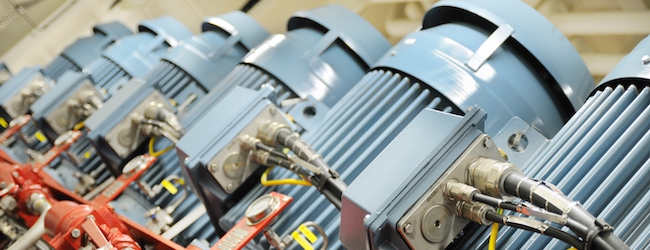
Features
Maintenance
Sawmilling
FAQs on repairing and replacing energy-efficient motors
April 26, 2016 - Tom Bishop of the Electrical Apparatus Service Association (EASA) sat down with Canadian Forest Industries to answer some of the frequently asked questions related to repairing and replacing energy-efficient motors:
How difficult is it to repair fabricated AC squirrel cage rotors - this type of failure was identified as not economically repairable?
In general, squirrel cage rotor rebuilding (rebarring) is a labor-intensive process. Die cast bars are usually removed in a chemical process; and fabricated bars are manually removed one at a time. Sometimes the thin steel disc laminations must be disassembled in order to remove the rotor bars. Therefore, this labor-intensive repair activity is not usually economically justified unless the motor is relatively large or has special features.
When discussing the repair versus replacement issue, we frequently do not have the efficiency of the older motor. For large horsepower motors, the difference is not that large between old motors and current high efficiency motors. Is there a source to help estimate the efficiency of the older motors?
Small and medium motors manufactured prior to the high efficiency regulations rarely had efficiency levels on their nameplates. Further, the methods for testing of motor efficiency were refined in the era beginning with high efficiency motors. What this all means is that even if a pre-high efficiency motor rated efficiency were known, the level of accuracy would be questionable.
A more practical but partially after-the-fact approach to assessing the impact on energy consumption would be to measure the motor power input for a specific load prior to replacement, and measure the power input after the replacement motor is installed. That would provide a direct comparison of energy consumption for a specific application.
What test should be done to a motor to assure nameplate efficiency after repair?
If the as-manufactured no load power input (no load watts) for the motor is known, the post-repair value can be compared to it. However, the as-manufactured power input is not often available from many manufacturers. A more practical method is to follow known good practices that include testing at key decision points during repair, which is the approach used in the EASA Accreditation Program for service centres.
How do you know the efficiency in an old motor if it does not have a nameplate?
If the motor does not have a nameplate it may be possible to locate identifying information, such as a serial number stamped into the frame or shaft, that can be traced back to the original information if the motor manufacturer is known. However, that is rarely the case. Thus, in general, if the motor lacks a nameplate the efficiency cannot be estimated. Further, it may not be possible to accurately determine the motor power, voltage and current ratings.
Can the efficiency classification of a motor be increased by rewinding?
Although efficiency may be improved by rewinding, an increase great enough to result in a pre-high efficiency motor becoming high efficiency, or a high efficiency motor becoming NEMA Premium would not be possible.
Of the total losses in a motor, how much relates to rewinding?
The losses directly affected by the rewinding process are stator winding copper and core losses. Stator copper losses are typically about 35 to 40 per cent of total losses; and stator core losses are typically about 10 to 15 per cent of total losses. Together they are about 50 to 55 per cent of total losses.
Should there be a concern about the difference in speed rating of a higher efficiency motor compared to an older motor?
The more efficient motor will typically have a higher full load speed rating; and if the application is a fan or a pump, the power requirement changes by the cube of the speed. For example, if a 1,725 rpm pump motor was replaced by a NEMA Premiummotor rated 1,790 rpm, the required power would be about 12 per cent greater [(1790/1725)3 = 1.12 12%].
Click here to read Tom Bishop’s feature article discussing whether to repair or replace energy-efficient motors.
April 26, 2016 By Andrew Snook

Print this page